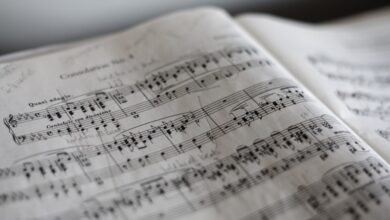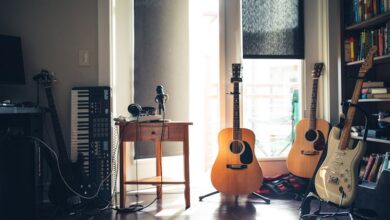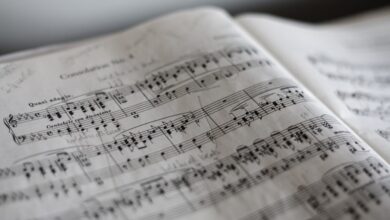Exploring the Impact of Music on Physical Rehabilitation and Therapy

Introduction:
Have you ever experienced the immense power of music that can make you feel uplifted, motivated, or even calm your mind? Well, it turns out that music does more than just entertain us. It has a remarkable impact on physical rehabilitation and therapy, unlocking new possibilities for healing and recovery. In this article, we will delve into the fascinating world of how music influences and enhances the journey towards physical well-being.
The Rhythmic Connection:
Music possesses a unique ability to synchronize with our bodies and minds. When incorporated into physical rehabilitation and therapy, it becomes a powerful tool. Whether it’s walking to the beat, pedaling on a stationary bike in time with a favorite tune, or stretching to melodic rhythms, music acts as a catalyst, promoting coordination and motor skills development. It engages our muscles, inviting movement, and making exercises more enjoyable.

Emotional Resonance:
Beyond its physical benefits, music taps into our emotional landscape. It can evoke memories, trigger emotions, and enhance mood. Incorporating music into rehabilitation sessions creates an environment that nurtures positivity and motivation, boosting patients’ spirits and reducing anxiety or stress. This emotional resonance can significantly impact the overall therapeutic experience and instill a sense of hope and determination in individuals undergoing rehabilitation.
Neurological Wonders:
The influence of music extends deep into the neurological realms of our brains. Studies have shown that listening to music activates multiple regions associated with memory, emotion, and movement. In cases of stroke or brain injuries, where the brain’s connections may be disrupted, music can help rewire neural pathways. By engaging various brain areas simultaneously, music stimulates neuroplasticity, aiding in the restoration of cognitive and motor functions.
Enhancing Focus and Endurance:
Recovery from physical injuries often requires perseverance and concentration. Music has the remarkable ability to capture our attention and provide a pleasant distraction from discomfort or fatigue during therapy sessions. It can increase endurance, helping individuals push through challenging exercises and attain their rehabilitation goals. Just like a personal cheerleader, music boosts motivation, enabling patients to surpass their limits.
Conclusion:
In the realm of physical rehabilitation and therapy, music emerges as a potent force for healing and transformation. Its rhythmic connection, emotional resonance, neurological wonders, and ability to enhance focus and endurance make it an invaluable tool in the recovery process. By incorporating music into rehabilitation programs, healthcare professionals can harness its awe-inspiring impact, creating an environment that fosters physical and emotional well-being. So, let the power of music guide you on your journey towards restoration, one beat at a time.
Melodies of Recovery: How Music is Transforming Physical Rehabilitation and Therapy
Introduction:
Have you ever wondered how music can work wonders in the realm of physical rehabilitation and therapy? It might surprise you to learn that the remarkable power of melodies goes beyond mere entertainment. In recent years, music has emerged as a transformative tool in helping individuals recover from physical injuries and enhance their overall well-being. This article dives into the captivating world of music and its profound impact on the process of recovery.
The Rhythm of Healing:
Music possesses an inherent ability to tap into our emotions and transcend language barriers. When integrated into physical rehabilitation programs, it engages both the body and mind, inspiring a holistic healing experience. The rhythm and melody stimulate movement, encouraging patients to regain motor skills, coordination, and balance. By synchronizing their movements with the beats, individuals find motivation, making their recovery journey more enjoyable and rewarding.
Emotional Resonance:
Beyond its physical benefits, music also holds immense emotional power. It has the uncanny ability to evoke memories, emotions, and even alter mood states. In the context of rehabilitation, music offers a therapeutic avenue for emotional expression and release. Listening to or creating music allows patients to channel their feelings, relieving stress and promoting mental well-being. This emotional resonance facilitates a positive mindset, which plays a crucial role in the recovery process.

Cognitive Stimulation:
Music acts as a catalyst for cognitive stimulation and neurological retraining. Engaging with melodies activates various parts of the brain, stimulating neural connections and enhancing cognitive functions. In stroke recovery, for instance, rhythmic patterns and melodic exercises help rebuild damaged pathways and improve speech and language skills. The brain’s response to music is awe-inspiring, and healthcare professionals are harnessing this potential to facilitate faster recoveries.
Creating a Harmonious Environment:
In rehabilitation settings, the ambiance plays a pivotal role in patient comfort and progress. Music fosters a harmonious environment, reducing anxiety and promoting relaxation. By incorporating soothing melodies, healthcare providers create spaces that encourage healing and rejuvenation. Patients can immerse themselves in the tranquil soundscape, easing physical discomfort and supporting the recovery process.
Conclusion:
The symphony of music has become an integral part of physical rehabilitation and therapy, unlocking new possibilities for recovery and well-being. Its ability to inspire movement, evoke emotions, stimulate cognition, and create a serene environment showcases the tremendous impact music has on transforming lives. As we continue to uncover the melodies of recovery, it is clear that music will remain a powerful ally in the pursuit of holistic healing.
Healing Harmonies: Uncovering the Power of Music in Physical Therapy

Introduction:
Picture a world where healing is not only possible through medication and medical interventions but also through the soothing power of music. In recent years, the integration of music into physical therapy has gained significant attention, revealing its remarkable potential in enhancing the recovery process for individuals facing various physical challenges. Let’s delve into the captivating realm of music’s healing harmonies and explore how it can positively impact physical therapy.
The Therapeutic Benefits of Music:
When it comes to physical therapy, music acts as a powerful catalyst that transcends traditional treatment methods. It has the profound ability to engage multiple senses simultaneously, evoking emotional responses, stimulating memories, and fostering a deep connection with one’s body. Incorporating music into therapy sessions creates a dynamic environment where patients can experience a heightened sense of motivation, relaxation, and joy.
Enhancing Movement and Rehabilitation:
Music possesses an innate ability to synchronize movement, making it an invaluable tool in physical rehabilitation. Rhythmic beats and melodies can serve as cues for coordinating and improving motor skills, enabling patients to regain strength and mobility. By harnessing the harmonious rhythms of music, therapists can create structured exercises that align with the tempo, helping individuals find their rhythm and achieve optimal physical performance.
Managing Pain and Stress:
Living with pain or undergoing physical therapy can be a daunting and stressful experience. However, music has the extraordinary power to alleviate these burdensome emotions. By engaging the brain’s pleasure centers, music releases endorphins, providing a natural pain relief mechanism. Additionally, it promotes relaxation, reduces anxiety levels, and diverts attention away from discomfort, allowing patients to focus on their healing journey.

Unlocking Emotional Expression:
Physical limitations can often lead to emotional distress and a sense of isolation. Music provides an outlet for self-expression, giving individuals a voice when words fail. It allows patients to explore and communicate their feelings, fostering emotional well-being alongside physical recovery. Whether it’s listening to music that resonates with personal experiences or participating in group music therapy sessions, the power of music helps bridge the gap between the body and the soul.
Conclusion:
Rhythm and Rehabilitation: The Surprising Effectiveness of Music in Healing
When it comes to healing, there’s one powerful tool that transcends language, culture, and time: music. It’s incredible how something as simple as a melody can have such a profound impact on our well-being. But what is it about music that makes it so effective in the realm of rehabilitation? Let’s dive into the captivating world of rhythm and explore its surprising benefits.
Have you ever found yourself tapping your foot or nodding your head to a catchy tune? Well, that rhythmic response has a lot more to offer than just a good beat. Studies have shown that music engages multiple areas of the brain simultaneously, stimulating cognitive processes and boosting memory. This cognitive stimulation becomes particularly meaningful in the context of rehabilitation, where patients often struggle with relearning skills and regaining mobility.
Music also possesses the remarkable ability to evoke emotions and stir up memories. Have you ever listened to a song from your childhood and instantly felt transported back in time? This emotional connection can be harnessed in therapeutic settings, helping patients tap into their inner reserves of motivation and resilience. Whether it’s through soothing melodies or upbeat rhythms, music has the power to uplift spirits and create a positive atmosphere for healing.
Moreover, music therapy has been proven effective in pain management. As the saying goes, “music heals the soul.” Listening to music releases endorphins, our body’s natural painkillers, which can alleviate discomfort and promote relaxation. By incorporating music into rehabilitation programs, healthcare professionals can enhance the overall well-being of patients and contribute to a quicker recovery process.
One fascinating aspect of music is its ability to synchronize movement and facilitate physical rehabilitation. Have you ever noticed how effortlessly dancers glide across the stage, perfectly in sync with the rhythm? This synchronization concept extends beyond dance. In rehabilitation, music can serve as a rhythmic cue, helping individuals coordinate their movements and regain motor skills. The rhythm acts as a guide, enhancing coordination, balance, and overall physical performance.
Soundtrack to Recovery: Music’s Role in Accelerating Physical Rehabilitation
Introduction:
Picture a world where the healing power of music meets the journey of physical rehabilitation. From the gentle strumming of a guitar to the rhythmic beats of a drum, music has the extraordinary ability to inspire, uplift, and accelerate the recovery process. In this article, we explore how music plays an instrumental role in aiding physical rehabilitation and its profound impact on patients.
The Therapeutic Rhythm:
Music has long been recognized for its therapeutic effects on the mind and soul. However, recent studies have shed light on its powerful influence on physical healing as well. When integrated with rehabilitation exercises, music acts as a catalyst, stimulating movement and enhancing overall recovery outcomes. It serves as a metronome, guiding patients through their exercises, promoting coordination, and improving motor skills.
Engaging the Brain:
The brain is a complex organ that plays a crucial role in the rehabilitation process. Music engages various regions of the brain, igniting neural pathways and facilitating the reconnection of damaged areas. The harmonies, melodies, and rhythms activate the reward centers, releasing dopamine and endorphins, which are essential for pain management and emotional well-being during recovery.
Mood Enhancement and Stress Reduction:
Recovering from physical injuries can be a challenging and emotionally taxing experience. Music acts as a soothing balm, alleviating stress and anxiety while boosting mood and motivation. Through its ability to evoke emotions, it creates a positive environment that fosters resilience, perseverance, and optimism, vital elements for successful rehabilitation.
Enhanced Focus and Cognitive Function:
When patients immerse themselves in music during rehabilitation sessions, it enhances their focus and cognitive function. The rhythm and tempo serve as anchors, enabling individuals to concentrate on their movements while blocking out distractions. This heightened focus facilitates better learning, retention, and execution of rehabilitative exercises.

Social Connection and Emotional Support:
Recovery can sometimes feel isolating, but music has the power to bridge that gap. Whether through group music therapy sessions or simply listening to favorite tunes, it fosters social connections and provides emotional support. Shared musical experiences create a sense of unity, empathy, and encouragement, boosting morale and promoting a faster recovery.
In conclusion:




